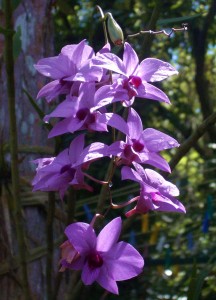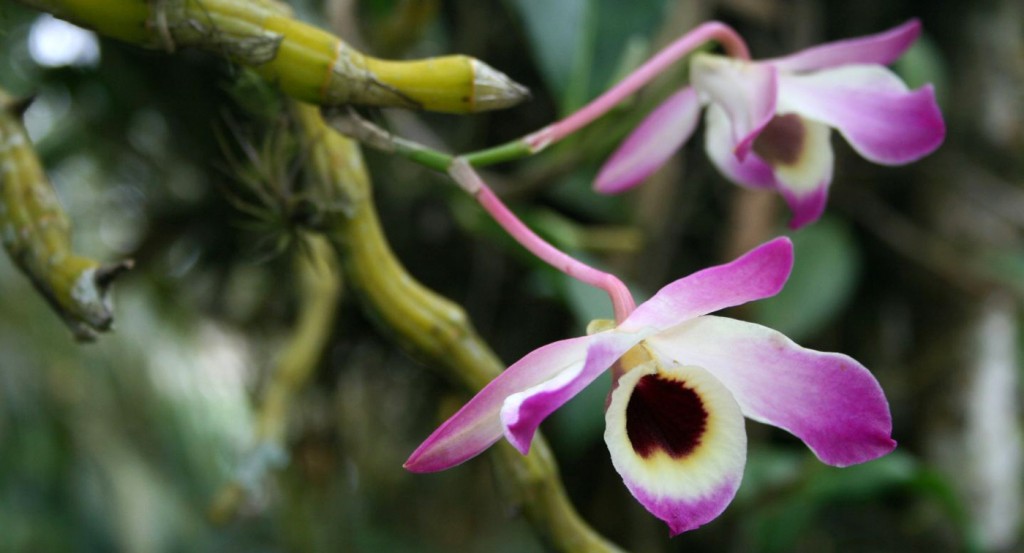Dendrobiums
Posted in Gardening Tips, The Orchid Show on March 20 2012, by Sonia Uyterhoeven
Sonia Uyterhoeven is the NYBG‘s Gardener for Public Education.

To the chagrin of my more tropically-inclined colleagues, I have been resisting the temptation to sing the praise of dendrobiums for years. “Give me an oncidium any day,” I used to exclaim. “They are easier to grow and I will not kill them!”
Initially, it was true… I had issues with dendrobiums. If the vegetative growth (foliage and pseudobulbs) in many orchids is fairly unattractive when they are out of bloom, the cane dendrobiums are positively ugly.
I do not like them in bloom; I do not like them out of bloom; I do not like them Sam-I-am with green eggs and ham! I was adamant. They looked like mutant orchids, outcasts in an otherwise pulchritudinous family–the Orchidaceae.
Time (and experience) is a great healer, and I have slowly come around to appreciate this genus. The other day I was in the Nolen Glasshouses drooling over some colorful evergreen Den-Phal dendrobiums–Dendrobium phalaenopsis hybrids. While you generally see the flowers in white, pink, and lavender, the ones that caught my eye were chartreuse with reddish-purple highlights–a color combination that I find divine if the tones are right.
Dendrobiums are no more complicated than other orchid genera, it is just important to understand who they are and what they need. Some dendrobiums such as the popular Dendrobium nobile hybrids are deciduous. They are not for the faint-hearted; they require a dormancy period in the fall when their growth comes to a screeching halt. They defoliate and you turn your back on them and walk away, leaving them alone in a bright, cool spot–neglected–for several months. This is not entirely true–in our arid home environments where orchids are starved for humidity, you will have to occasionally mist them so the canes do not shrivel and dry.
Dendrobium nobileis from the Himalayan foothills, where it encounters wet summers and cool, dry winters. These orchids like to grow like gangbusters in the summer and have their cool rest in the fall to winter, before they flower and start up again. Research has shown that they are more likely to flower if the night time temperature in the fall and winter drops to around 55 F. If that is impossible, try to keep it under 65 degrees Fahrenheit, otherwise there is a good chance that you will get keikis (a baby orchid) instead of flowers. Water them every two to three days in the summer and fertilize them once a week. Discontinue this regime in the fall. They grow best in bright, indirect light in a southern window and may need a sheer curtain for protection from the intense heat of the summer sun.

Equally popular evergreen dendrobiums are the Den-Phal type whose flowers look like small moth orchids, or the antelope dendrobiums with their twisted hornlike petals. These dendrobiums require more consistency in their lives–a sunny southern or western window with bright, indirect light and warm temperatures. Since many of them herald from Malaysia, New Guinea and Australia, they are ideal for homeowners living in Hawaii and Florida. For those of us who live in the northeast, it simply gives us an idea of what we are trying to create.
In terms of watering, these evergreen dendrobiums like moisture when they are growing and prefer things a little more dry in the winter months once they have reached mature growth. Fertilize weekly during the growing season. Restricting water and fertilizer in the winter months (reduce by about 20 to 30%) will help trigger flowering.
Dendrobiums like good drainage and will not tolerate wet roots, so provide them with a free-draining orchid mix. They also have a small root system and love to be pot-bound, so grow them in a small clay pot and place them in a large cache pot for stability. Increasing the humidity around the orchid by placing pots on trays full of pebbles and water (drywell) will be appreciated by this exotic orchid.
Dendrobiums come in a vast array of shades, including red, orange, yellow, white, pink, lavender, chartreuse and many elaborate permutations within that color spectrum. Like many other orchids, they are a joy to grow once you get the swing of it. My rejoinder has since changed from my initial mantra of “I will not grow them here, I will not grow them there; I will not grow them anywhere.” With a little hand holding, I managed to pass under the lintel and move into a more complete realm that includes dendrobiums as part of my repertoire.
The Orchid Show runs until April 22, with numerous lectures, workshops, and exciting activities to take part in. Be sure to reserve your tickets.
Photos courtesy of Wikimedia Commons.

